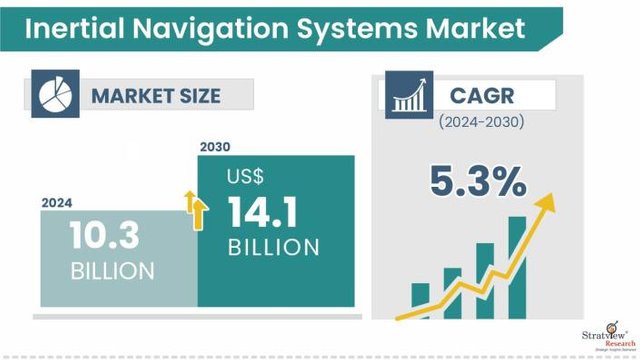Inertial Navigation System Market: The Backbone of Modern Navigation Technologies
Inertial Navigation Systems (INS) are crucial in navigation and positioning applications, particularly where GPS signals are unavailable or unreliable. INS combines accelerometers, gyroscopes, and magnetometers to provide accurate positioning and orientation data by measuring linear acceleration and angular velocity. These systems are widely used in aerospace, defense, automotive, and marine applications, where precision and reliability are paramount.
According to Stratview Research, the Inertial Navigation Systems Market is projected to grow at a CAGR of 5.3% from 2024 to 2030, reaching USD 14.1 billion by 2030. This growth is driven by increasing demand for autonomous navigation, military applications, and advances in MEMS technology.
Request a sample report to preview our in-depth analysis:
https://stratviewresearch.com/Request-Sample/4022/inertial-navigation-systems-market.html#form
 What is an Inertial Navigation System?
What is an Inertial Navigation System?
An inertial navigation system is a self-contained system that uses motion sensors to track an object's movement relative to a known starting point. INS provides real-time data on position, velocity, and orientation without relying on external references such as satellite signals. This makes it especially valuable in environments like underground tunnels, submarines, and aircraft that need continuous and accurate positioning.
Key Applications of Inertial Navigation Systems
1. Aerospace and Defense: In aerospace, INS plays a critical role in aircraft navigation, missile guidance, and spacecraft. INS ensures accurate positioning and guidance when external signals like GPS are disrupted, which is particularly crucial in military operations and space missions.
2. Automotive and Autonomous Vehicles: INS is increasingly being integrated into autonomous vehicles and driver-assist systems for precise navigation in GPS-denied environments. It is used to enhance safety and reliability in self-driving cars, helping them navigate through urban streets, tunnels, and underground parking garages.
3. Marine Applications: In marine environments, INS is used for navigation and positioning of ships, submarines, and underwater vehicles. It is crucial for accurate route tracking when operating in areas where satellite signals may not be available.
Market Drivers for Inertial Navigation Systems
1. Growth in Autonomous Vehicles: The rise of autonomous vehicles is one of the major drivers of the INS market. Autonomous systems require precise, real-time data to operate safely, and INS provides a reliable backup when GPS signals are weak or unavailable.
2. Advancements in MEMS Technology: Micro-electromechanical systems (MEMS) are revolutionizing the INS market by providing smaller, more affordable sensors that maintain high accuracy. MEMS-based INS are being increasingly used in consumer electronics, drones, and wearable devices due to their cost-effectiveness and small size.
3. Military and Defense Applications: The military continues to drive demand for high-precision navigation systems that operate in GPS-denied environments. INS provides resilient and secure navigation in missile guidance systems, drones, and unmanned aerial vehicles (UAVs).
Challenges in the Inertial Navigation System Market
1. High Cost of Advanced INS Units: High-end fiber-optic and ring laser gyroscopes used in military-grade INS are expensive. The high cost of these systems can limit their adoption in commercial applications, such as consumer electronics and small drones.
2. Accuracy and Drift Issues: Over time, even the most advanced INS systems may experience drift due to minor sensor inaccuracies, which can accumulate and lead to positioning errors. Calibration and sensor fusion with other technologies like GPS are necessary to maintain long-term accuracy.
Conclusion
The Inertial Navigation System Market is experiencing significant growth due to increasing demand for autonomous navigation, military applications, and advancements in MEMS technology. As the need for high-precision navigation continues to rise, INS systems will play a crucial role in the future of navigation technologies across industries.